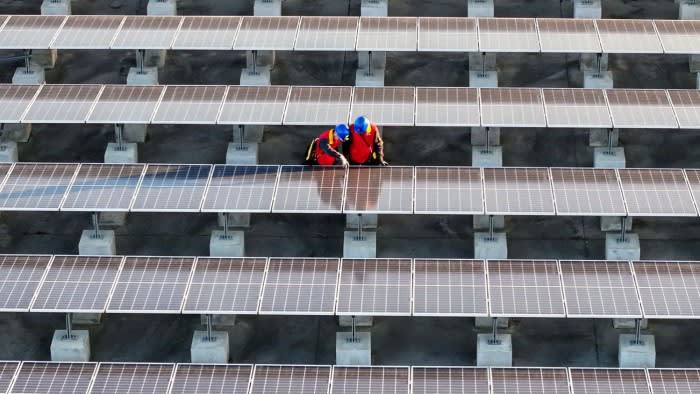Stay informed with free updates
Simply sign up to the Renewable energy myFT Digest — delivered directly to your inbox.
The writer is an FT contributing editor and writes the Chartbook newsletter
Since the Biden administration passed the Inflation Reduction Act in 2022, we have been worrying about a green industrial subsidy race. Talk about Chinese “overcapacity” has perpetuated that narrative. Competitive subsidies may entail a waste of real resources and taxpayers’ money. Tariffs on solar panels and electric vehicles risk spilling over into a wider trade war.
But what if, over the next 12 months, the three main protagonists — the US, China and the EU — call it off? Though it is carried forward by powerful technological innovation and declining costs, the green energy boom may prove less robust than many of us hope.
The EU has to renew the Next Generation EU commitments beyond 2026 to prevent the support offered to the Green Deal drying up. Following the European parliament elections in 2019, the direction of policy was clearly green. After the EU elections last month, with the shift to the right, that is no longer the case. The French legislative elections are likely to reinforce the turn against an accelerated green policy. Marine Le Pen’s camp are not climate sceptics like Donald Trump. But one of the Rassemblement National’s firmest promises is to lower the price of diesel for its van-driving constituency.
If Trump is elected in the US, he has promised to gut Joe Biden’s energy transition subsidies. The Biden team anticipated this and made the subsidies so friendly to industry that a business lobby is already rallying to their defence. But the difference between genuine energy transformation and greenwashing is a fine one. By tweaking administrative regulations, the IRA could be turned into a subsidy engine for pet projects of the oil lobby, such as dirty hydrogen.
If Biden is re-elected, the US will stay the green course. Yet, barring a miracle, there is little or no hope of a congressional majority for new climate legislation. The IRA is the best we can hope for.
But the significance of what happens in Europe and the US is dwarfed by the decisions that Beijing has to make in the next 12 months. China emits more greenhouse gases than Europe and the US put together, and its green energy investment in 2024 is larger than that of either Europe or the US. China’s green energy investment in photovoltaic technology, batteries, new energy vehicles and long-range ultra-high voltage transmission is the first to achieve the scale at which it truly begins to transform the economic landscape as a whole. In 2023, according to calculations by the CREA think-tank, green energy investment was the single largest driver of China’s economic growth.
Between now and the spring of 2025, China has to formulate its new commitments to decarbonisation under the Paris climate accords. The question is whether Beijing’s planners have the courage and conviction to throw their weight behind the startling pace at which China’s businesses are driving the energy transition, or whether they retreat to a more cautious line.
As Lauri Myllyvirta, one of the west’s leading China energy experts, has noted, there is a worrying gap between the pace of change actually achieved in the past few years, and the future vision seemingly favoured by Beijing’s top energy bureaucrats. Whereas China’s solar and wind industry installed almost 300GW of new capacity in 2023, its National Energy Agency envisions a future buildout of barely more than 100GW a year.
To explain its caution, the NEA points to the need for more co-ordination in green energy investment and more smoothly operating pricing systems to make a renewable system reliable. These are problems familiar in the west. But if they were to stifle China’s world-changing green energy boom, it would be a disaster of historic proportions.
The extraordinary pace of China’s green energy investment in recent years may trigger defensive reactions in the west. But it is our best hope of actually achieving climate stabilisation in time to stave off planetary disaster. Faced with the urgency of this task, to think in terms of balance of equilibrium is tantamount to a soft form of climate denial. It will make the challenge of achieving neutrality before 2060 even more daunting. And in so doing it undermines the credibility of commitment, which is fundamental to building a broad-based coalition around decarbonisation.
In 2008-09, China’s heavy-industrial stimulus carried much of the world’s growth and took global CO₂ emissions to new heights. On the decisions of the next 12 months hangs the question of whether the country will carry the momentum of global green growth in years to come.


